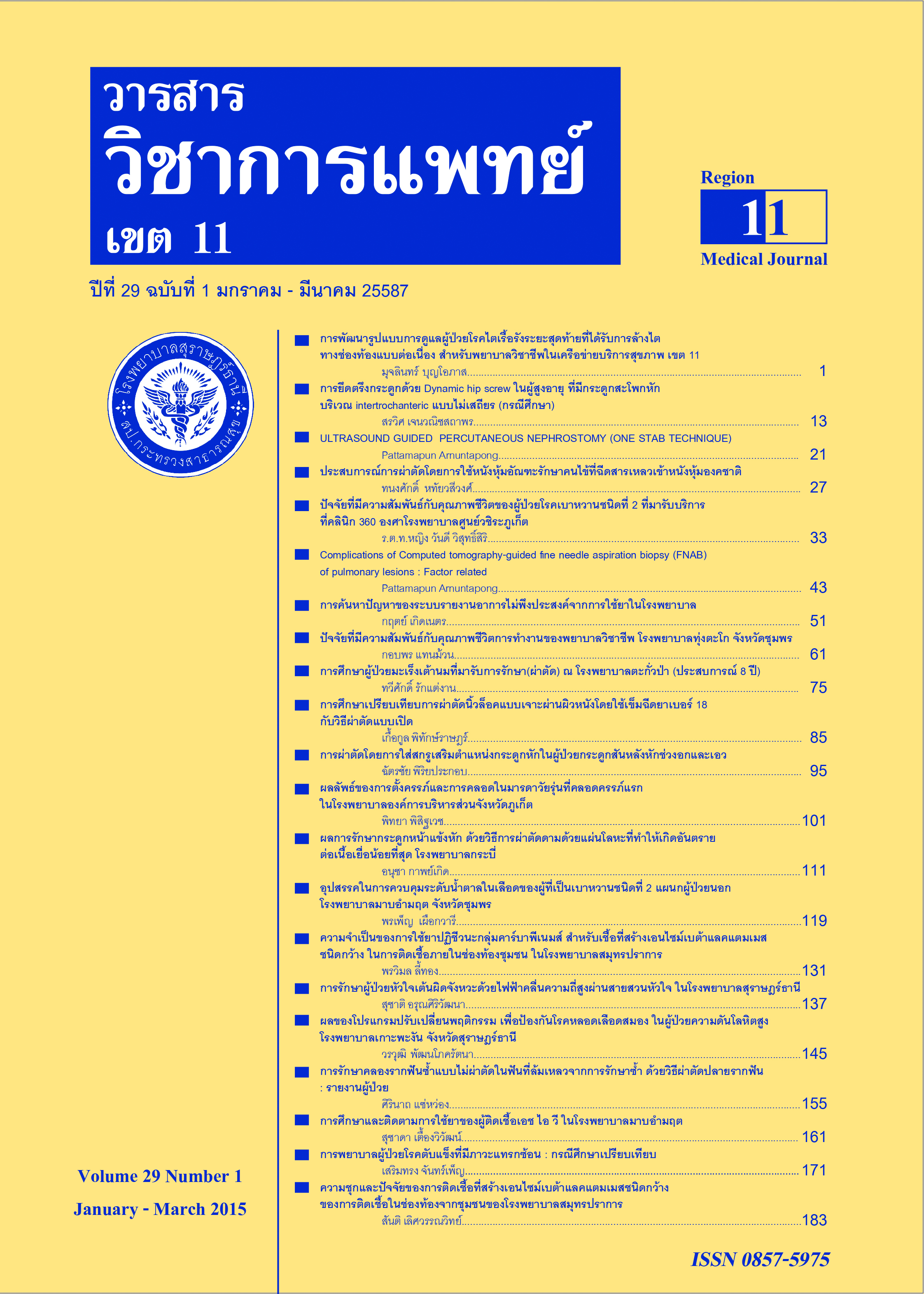Barriers to Glycemic Control Among Persons with Diabetes Mellitus Type 2 in Out Patient Department at Mabammarit Hospital, Chumphon Province
Keywords:
Barriers, Glycemic Control, Persons with Diabetes Mellitus type 2Abstract
The purpose of the descriptive study was to determine barriers to glycemic control and strategic management of such barriers. The subjects were 90 persons with diabetes mellitus type 2 in Out Patient Department at Mabammarit Hospital, Chumphon Province between August 2014 to October 2014. The research instruments included a Demographic Data Record Form and Barriers and the Strategic Management of Glycemic Control Questionnaire that of Jiraporn Gunboon(1). The overall reliability of the Barriers to Glycemic Control Questionnaire, examined by test-retest method, was .90. The reliability
of each aspect of the Barriers to Glycemic Control Questionnaire, namely barriers to dietary control, medication taking, and exercise were .80, .83, and .81, respectively. Data were analyzed by using Descriptive statistics.
The results of the study revealed that :
1. The subjects had a low level of overall barriers to glycemic control ( =17.53, S.D. =9.24). Considering each aspect, 98.89% subjects had barriers to dietary control at low level ( X=7.33, S.D. =4.30), 95.56% reported of having barriers to medication taking at a low level (X=4.41, S.D. =2.94), and 94.44% reported of barriers to exercise at low level (X=5.79, S.D. =3.91).
2. The subjects suggested that strategic management for dietary control by self management should be self-control (30%), dietary control adherence (17.78%), and avoidance (17.78%). Barrier management by depending on others should involve the cooperation of family members in appropriate eating
( 4.44%) and cooking (3.33%).
3. The subjects suggested that strategic management for medication taking by self management should be medication adherence (25.55%). Barrier management by depending on others should to be reminded by family members (7.78%).
4. The subjects stated that strategic management for exercise by self management should be finding a suitable exercise method (28.89%), time management (21.11%), and self-control (16.67%). Barrier management by depending on others should be exercise prescribed by physicians (10%) and motivation by family members (6.66%)
References
2. นุชรี อาบสุวรรณ และ นิตยา พันธุเวทย์. ประเด็นสารรณรงค์วันเบาหวานโลกปี 2556 (ปีงบประมาณ 2557). กรุงเทพฯ: สำนักโรคไม่ติดต่อ; 2557.
3. สุธาทิพย์ ภัทรกุลวณิชย์. ประเด็นสารรณรงค์วันเบาหวานโลกปี 2555 (ปีงบประมาณ 2556). กรุงเทพฯ:สำนักโรคไม่ติดต่อ; 2556.
4. Changing diabetes. เกี่ยวกับโรคเบาหวาน. URL: http//www.changingdiabetesthailand.com/aboutdiabetes_th.php. สืบค้นเมื่อ 15 กันยายน 2557.
5. American Diabetes Association. Summary of revision for the 2006 clinical practice recommendations. Diabetes 2006; suppli:s3-s42.
6. Black JM, Matassarin-Jacobs E. Luckmann and Sorensens, Medical-Surgical Nursing : A Psycohphysiologic Approach. 4th ed. Philadel phia: W.B. Saunders; 1993.
7. Kielhofner G. A model of human occupation :Theory and application. 2nd ed. Baltimore : Williams & Wikins; 1995.
8. Polit DF, Hungler BP. Nursing research: Principles and methods. 7th ed. Philadelphia: Lippincott Williams & Wilkins; 2004.
9. อภิรดี ปลอดในเมือง. ประสิทธิภาพของโครงการสนับสนุนและให้ความรู้เพื่อปรับปรุงการรับรู้สมรรถนะในการดูแลตนเอง และภาวะการควบคุมโรคในผู้ป่วยเบาหวานประเภทที่ 2 ที่ควบคุมโรคไม่ได้. กรุงเทพฯ:มหาวิทยาลัยมหิดล; 2542.
10. Nitiyanant W, Chetthakul T, Sang AKP, Therakiatkumjorn C, Kunsuikmengrai K, & Yeo JP. A survey study on diabetes management and complication
status in primary care setting in Thailand. J Med Assoc Thai 2007; 1:65-71.
11. พรทิพย์ มาลาธรรม, ปิยนันท์ พรหมคง, และ ประคอง อินทรสมบัติ. ปัจจัยทำนายระดับน้ำตาลในเลือดของผู้สูงอายุที่เป็นโรคเบาหวานชนิดที่ 2. Rama Nurs J
2010;2:218-237.
12. สุพัตรา สุภาพ. สังคมและวัฒนธรรมไทย: ค่านิยมครอบครัว ศาสนา ประเพณี. พิมพ์ครั้งที่ 11. กรุงเทพฯ: ไทยวัฒนพานิช; 2543.
13. Bumrungrad International. เบาหวาน (Diabetes).URL: http//www.bumrungrad.com/men-healthcenter/th/Diabetes.aspx. สืบค้นเมื่อ 15 กันยายน 2557.
14. วิมลรัตน์ จงเจริญ, วันดี คหะวงศ์, อังศุมา อภิชาโต, อรนิช แสงจันทร์, ประภาพร ชูกำเหนิด, กัลป์ยานี บุญสิน, และถนอม ชูงาน. รูปแบบการส่งเสริมการดูแลตนเองเพื่อควบคุมระดับน้ำตาลในเลือดของผู้ป่วยเบาหวานชนิดที่ 2. สงขลานครินทร์เวชสาร 2551;1:71-84.
15. รัชมนภรณ์ เจริญ, น้ำอ้อย ภักดีวงศ์, และ อำภาพร นามวงศ์พรหม. ผลของโปรแกรมพัฒนาความรู้และการมีส่วนร่วมของครอบครัวต่อพฤติกรรมสุขภาพและการควบคุมน้ำตาลในเลือดของผู้สูงอายุที่เป็นเบาหวานชนิดที่ 2. Rama Nurs J 2010;2:279-292.
16. สุภาพร เกื้อสุวรรณ. ปัจจัยที่มีอิทธิพลต่อพฤติกรรมการส่งเสริมตนเองและครอบครัวของผู้มารับบริการที่โรงพยาบาลศรีบรรพต จังหวัดพัทลุง. กรุงเทพฯ :มหาวิทยาลัยเกษตรศาสตร์; 2546.
17. Fitzpatrick SE, Reddy S, Lommel TS, Fischer JG, Speer EM, Stephens H, et al. Physical activity and physical function improved following a community-
based intervention in older adults in Gorgia senior centers. Journal of Nutrition for the Elderly 2008;1-2:135-154.





